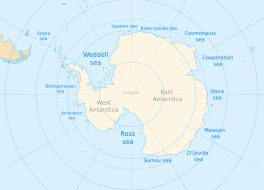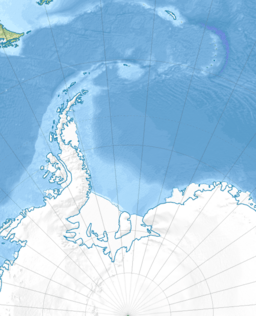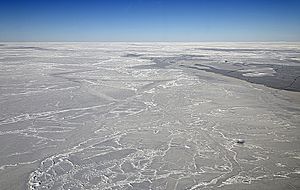Weddell Sea facts for kids
Quick facts for kids Weddell Sea |
|
|---|---|

The location of the Weddell Sea, part of the Southern Ocean
|
|

Map of the Weddell Sea with bathymetry and surrounding relief
|
|
| Location | Southern Ocean |
| Coordinates | 73°S 45°W / 73°S 45°W |
| Type | Sea |
| Basin countries | Argentine Antarctica, British Antarctic Territory, partially within the Antarctic Chilean Territory. |
| Surface area | 2,800,000 km2 (1,081,100 sq mi) |
| Average depth | 500 m (1,640 ft) |
| Max. depth | 5,148 m (16,890 ft) |
| Frozen | partially |
The Weddell Sea is a large part of the Southern Ocean. It is located near the continent of Antarctica. This sea is bordered by Coats Land and the Antarctic Peninsula. Its eastern edge is Cape Norvegia.
The Weddell Sea is huge, about 2,000 kilometres (1,200 mi) wide. Its total area is around 2.8 million square kilometres (1.1×106 sq mi). A large part of its southern area is covered by a giant, permanent ice shelf called the Filchner-Ronne Ice Shelf.
Scientists have found that the Weddell Sea has the clearest water of any sea on Earth. In 1986, researchers saw a special disc, called a Secchi disc, at a depth of 80 metres (260 ft). This means the water was as clear as distilled water!
Historian Thomas R. Henry wrote in 1950 that the Weddell Sea is very challenging to sail through. He mentioned stories of green-haired merman and sudden "flash freezes." These freezes could trap ships, like Ernest Shackleton's Endurance, in the ice.
Contents
Why is it called the Weddell Sea?
The sea is named after a Scottish sailor, James Weddell. He sailed into this sea in 1823. He first named it after King George IV. But in 1900, it was renamed in Weddell's honor.
In 1823, another sailor, Benjamin Morrell, claimed to see land to the east. He called it New South Greenland. However, later explorations in the early 1900s showed this land did not exist.
History of Exploration
British sailor James Weddell discovered the Weddell Sea in 1823. Later, in 1901–1904, Otto Nordenskiöld led the Swedish Antarctic Expedition. His team spent a winter on Snow Hill Island. Their relief ship got stuck in the ice and was crushed.
The crew managed to reach Paulet Island. They survived the winter in a simple hut. The Argentine Navy eventually rescued Nordenskiöld and his team at Hope Bay. Almost everyone survived this tough experience.
The Antarctic Sound is named after Nordenskiöld's expedition ship. This sound separates the tip of the Antarctic Peninsula from Dundee Island. It is also known as "Iceberg Alley." This is because many huge icebergs are often seen there.
In 1915, Ernest Shackleton's ship, Endurance, became trapped and was crushed by ice in this sea. After 15 months on the floating ice, Shackleton and his men reached Elephant Island. They all safely returned home. In March 2022, the well-preserved wreck of the Endurance was found. It was discovered about four miles (6.4 km) from where it was expected, at a depth of 3,008 metres (9,869 ft).
What is the Weddell Sea like?
The Weddell Sea is a very important place for ocean currents. It helps form deep water masses. These deep waters then move around the world's oceans. This movement is like a giant conveyor belt. It helps to spread heat and nutrients.
The water in the Weddell Sea becomes very cold and salty. This happens because of strong winds and ice forming. When sea ice forms, it pushes out salt. This makes the water around it even saltier and denser. This dense water then sinks.
The western part of the Weddell Sea has a strong current flowing north. This current is part of a large, circular ocean current system. It's called the Weddell Gyre. This gyre is mostly driven by winds. It helps move water out of the Weddell Sea.
The Weddell Gyre has a cold, less salty top layer. Below that is a warmer, saltier layer. This warmer layer is called Weddell Deep Water.
Weather and Climate
The weather in the western Weddell Sea is special. Strong winds blow along the tall mountains of the Antarctic Peninsula. These winds carry cold air. They also push ice northeast into the South Atlantic Ocean.
There's a big difference in wind, temperature, and ice conditions. One side of the Antarctic Peninsula is very different from the other. Strong winds blowing along the east side of the peninsula can happen in two ways. Either a strong storm is over the central Weddell Sea. Or, there's a wide flow of cold air over the southern Weddell Sea.
These conditions cause cold air to build up against the mountains. This creates a high-pressure area over the peninsula. This high pressure then pushes the wind to blow along the mountain wall.
Animals of the Weddell Sea
The Weddell Sea is full of amazing animals! You can find many whales and seals here. Some common animals include the Weddell seal and killer whales. You might also see humpback whales, minke whales, leopard seals, and crabeater seals.
The Adélie penguin is the most common penguin in this area. They are very good at living in the harsh, cold environment. A huge group of over 100,000 Adélie penguin pairs lives on volcanic Paulet Island.
Around 1997, the northernmost group of emperor penguins was found. They live just south of Snowhill Island in the Weddell Sea. Because the Weddell Sea often has thick ice, special ice-breaking ships with helicopters are needed to reach this colony.
In 2021, scientists found sponges and other animals living under the Filchner-Ronne Ice Shelf. They were on a rock at a depth of 1,233 metres (4,045 ft). This was 260 kilometres (160 mi) away from open water!
In February 2021, researchers found a huge group of about 60 million Jonah's icefish. They live in an area of the Weddell Sea. It's estimated that this group covers about 240 square kilometers. There's about one fish nest for every three square meters!
Seabed Features
The bottom of the Weddell Sea has many interesting features:
- Albert Bank
- Behm Bank
- Belgrano Bank
- Berkner Bank
- Helmert Bank
- Vinci Bank
- Andenes Knoll
- Explora Knoll
- Polarstern Knoll
- Hofmann Trough
- Möller Trough
- Rinner Trough
See also
 In Spanish: Mar de Weddell para niños
In Spanish: Mar de Weddell para niños



